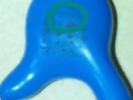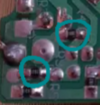An adjustable shunt regulator, as per:
Thanks!
I would check the input and output voltages around that, with it powered up..
An adjustable shunt regulator, as per:
If the capacitor were a high voltage reservoir capacitor then yes. It would be a safety resistor, to drain off charge quickly after the power is switched off.Is it normal to have an SMD connecting the 2 legs of a capacitor?
This is a cheap as it gets PSU. So, nothing fancy like that for it. But, the LED stays on after unplug. I imagine that does the draining.If the capacitor were a high voltage reservoir capacitor then yes. It would be a safety resistor, to drain off charge quickly after the power is switched off.
Yes, but it could also drain through these two resistors (R9 and 10 on the schematic), if the LED were to fail.the LED stays on after unplug. I imagine that does the draining
That's the 'Class Y' capacitor.Impossible to identify this capacitor. It measures 1.45-1.48nF

I wonder what caused it to fail: bad luck or bad load?
Out of curiosity, what controls the output voltage?
Find the potential divider network, adjust the values of those components, and you will adjust the voltage output.

If you need to find a tradesperson to get your job done, please try our local search below, or if you are doing it yourself you can find suppliers local to you.
Select the supplier or trade you require, enter your location to begin your search.
Are you a trade or supplier? You can create your listing free at DIYnot Local
